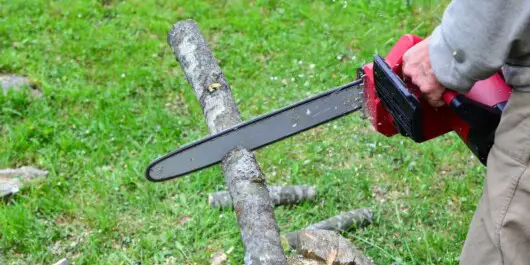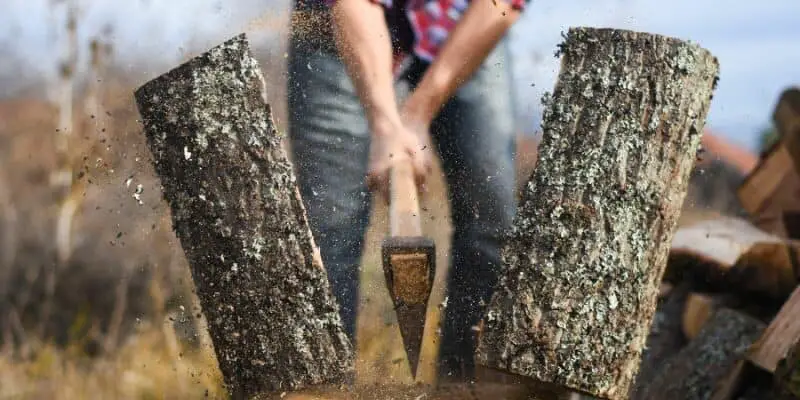Are you a homeowner wondering if it is possible to split fresh cut wood? If yes, then you’re definitely in the right place at the right time.
Splitting fresh cut wood is not necessarily a smart idea, as splitting dry wood is considerably easier than splitting freshly cut wet wood. However, despite being more difficult to cut, some people prefer splitting wet wood as it encourages faster drying times. While splitting fresh wood can be much more difficult than splitting dry wood, it’ll make the wood dry faster. The bark will act as a barrier that holds the moisture. Once the wood is split, the moisture would evaporate from the wood. The less bark the wooden logs have, the quicker they will dry.
In this article, you will get to know all about splitting freshly-cut wood, can you split fresh cut wood, how long should you wait to split wood after cutting down a tree, can you split wet wood, and more. Continue reading to get all the answers that you are looking for.
Why should you be splitting wood?
Splitting is an important step when it comes to creating high-quality firewood. Whether you’re using an ax or a hydraulic log splitter, splitting wood will create smaller pieces of firewood that are easier to burn. If you intend to split wood in preparation for winter, you might be wondering if it is easier to split freshly cut wood or dry wood.
Before answering can you split fresh cut wood, you’ll first get to have a closer look at the purpose of splitting wood. Log splitting is performed primarily to create firewood that is easier to burn than whole logs. There are some tree species, including most hardwoods, which have fire-resistant bark. The bark can still ignite, but it will take hotter temperatures than barkless wood.
Splitting wood will create smaller pieces of wood that have less bark. This makes them easier to ignite and stay lit with greater ease than whole logs. Splitting will also expedite the drying or seasoning process. All firewood should be dry burning, and otherwise, it’ll produce an excessive amount of smoke and minimal heat. Leaving wood exposed to the outdoor air typically dries it out within 6 to 12 months. Just ensure that the logs are properly stacked and covered. Splitting wood, however, will speed up the entire process so that wood dries out more quickly.
Moreover, this is because splitting will lower the surface area of bark. With less bark covering the surface of wood, moisture evaporates from its pores more quickly.
Lastly, splitting logs will create smaller pieces of firewood that are appropriate for most fire pits, smokers, grills, stoves, and fireplaces. You can discover that whole wooden logs are too large to fit inside the wood-burning accessories. Once split, the whole logs can be cut into pieces around one-third of their original size.
Can you split fresh cut wood?
Different tree species come with different organic compositions. Some species, for example, are denser than others, which makes them more difficult to split. Normally, you will find that dry, seasoned wood is much easier to split than wet wood. Regardless of the species of the tree from which it was harvested, dry wood will contain less moisture, which means there is less resistance when cutting and splitting it. A log splitter blade will be able to cut through dry wood thanks to the low moisture content.
Cutting wet wood is more difficult than splitting dry wood. However, some people prefer splitting wet wood as it encourages faster drying times. Split wood will contain less bark, so moisture will be released from it more quickly. A stack of whole logs could take a year or even longer to fully season, while a similar-sized stack of wood might take just 6 months or so to season. For that reason, it isn’t uncommon for individuals to split wood immediately after harvesting it, after which it can be left to dry.
If you’re unable to split wet wood using an ax, you should consider investing in a decent log splitter. A log splitter will live up to its name by automating the entire time-consuming process. These machines feature a gas-powered engine capable of cutting through wood with 10-30 tons of force. You’ll be able to easily split entire cords of wet or dry wood using a high-quality log splitter. This is a smart investment for anyone who harvests their own wood from time to time.
However, the high cost of a log splitter might deter some people from purchasing it. A standard consumer-grade log splitter will cost anywhere between $500 and $5,000. The commercial-grade log splitters will cost even more. You should also consider how much wood you need to split to determine if the log splitter is worth the cost.
You should also remember that some types of wood will be easier to split when wet. For instance, Oak is a popular hardwood that is easier to split when wet. When initially harvested, you’ll be able to split wet or green oak without having to wait for it to dry first. For many other species, you’ll probably find that dry wood is easier to split.

How long should you wait to split wood after cutting down a tree?
Interestingly, there are both pros and cons to splitting freshly cut wood. If you want the entire process to be as quick and easy as possible, you must opt for splitting dry wood. It’ll be easier to split than wet wood. The wood having too much moisture building could cause resistance, which makes wet wood more difficult to chop. However, this will also depend on the type of wood.
Green wood vs. wet wood
Green wood and wet wood aren’t the same. Green wood is used for referring to newly logged trees. It has got higher moisture content than wood that has already been cut down for a while. Some find it easier to chop down green wood. However, this will depend on the type of wood you are cutting.
Conifer wood vs. deciduous trees
Conifer trees like pines are much easier to split when they are dry. They are slightly too sappy and soft when they are fresh. Deciduous trees, on the other hand, like maple and oak trees, are much more difficult to chop when they are dry. This is the case because they are extremely dense and solid once they have dried out.
Seasoning split wood
Splitting wooden logs while they are wet or green accelerates the seasoning process. Seasoned wood is just wood that has had time to dry. Whole logs will take longer to dry because the bark holds up the moisture. When you are splitting the wood into sections, the moisture can escape and evaporate easily. In general, whole logs could take anywhere between 9-12 months to season. Meanwhile, split wood will only take around 6 months to season. Of course, it will depend on the conditions to which the wood has been exposed.
How long will split wood take to dry?
In most cases, split wood will take around 6 months or so to dry. Times can vary as it’ll depend on numerous factors including moisture content, type of wood, storage, wood size, and weather conditions. If the wood has been exposed to rain or snow, it’ll take longer to dry. If the wood is getting a lot of sun and wind, it’ll dry out faster. Some types of wood are prone to longer drying times. Smaller pieces of wood dry out faster than large chunks. Likewise, wood that has little to no bark dries faster than pieces with excess bark. A decent moisture meter will help you know the moisture content present in the wooden logs.
Conclusion
Thank you for reading. Hopefully, now you know a lot more about splitting freshly cut wood, can you split fresh cut wood, how long should you wait to split wood after cutting down a tree, can you split wet wood, and more. Splitting fresh cut wood is not necessarily a smart idea, as splitting dry wood is considerably easier than splitting freshly-cut wet wood.
However, despite being more difficult to cut, some people prefer splitting wet wood as it encourages faster drying times. While splitting fresh wood can be much more difficult than splitting dry wood, it’ll make the wood dry faster. The bark will act as a barrier that holds the moisture. Once the wood is split, the moisture would evaporate from the wood. The less bark the wooden logs have, the quicker they will dry.


